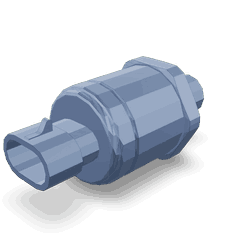This truck part is made by Cummins®. We guarantee that all of our parts are from the OEM (original equipment manufacturer), ensuring a proper fit and quality manufacturing.
We honor the warranty provided by the original equipment manufacturer.
Introduction
The Cummins 3408519 Pressure Sensor is a component designed for use in commercial truck operations. It serves to monitor and regulate pressure levels within the truck’s systems, contributing to the overall efficiency and reliability of the vehicle. This sensor is integral to maintaining optimal performance and ensuring the longevity of the truck’s components.
Basic Concepts of Pressure Sensors
Pressure sensors are devices that measure the force exerted by a fluid (liquid or gas) on a surface. They convert this physical pressure into an electrical signal, which can then be interpreted by the vehicle’s electronic systems. In automotive applications, pressure sensors are used in various systems, including fuel injection, brake systems, and engine management, to ensure that these systems operate within their designed parameters 1.
Role of the 3408519 Pressure Sensor in Truck Operation
The 3408519 Pressure Sensor plays a specific role in the operation of a commercial truck by monitoring the pressure within the fuel system. It provides real-time data to the truck’s electronic control unit (ECU), allowing for precise adjustments to fuel delivery and engine performance. This integration into the truck’s systems helps maintain efficient combustion and reduces the risk of engine damage due to incorrect fuel pressure 2.
Key Features of the 3408519 Pressure Sensor
The 3408519 Pressure Sensor is characterized by its robust design and high-quality materials, which ensure durability and accurate performance. It incorporates advanced technological specifications, such as a high-resolution output signal and resistance to environmental factors, which enhance its reliability in demanding commercial truck applications.
Benefits of Using the 3408519 Pressure Sensor
Incorporating the 3408519 Pressure Sensor into truck systems offers several advantages. It contributes to improved fuel efficiency by ensuring optimal fuel pressure, enhances the reliability of the fuel system through precise monitoring, and supports overall engine performance by providing accurate data for the ECU to make informed adjustments 3.
Installation and Integration
Proper installation of the 3408519 Pressure Sensor involves careful alignment with the truck’s fuel system and secure mounting to prevent damage from vibrations. It is important to follow manufacturer guidelines for integration, ensuring that all connections are secure and that the sensor is correctly calibrated to the truck’s specific requirements.
Troubleshooting Common Issues
Common issues with the 3408519 Pressure Sensor may include inaccurate readings or sensor failure. Troubleshooting steps involve checking the sensor’s connections, verifying its calibration, and inspecting for physical damage. Solutions may range from recalibration to replacement, depending on the issue identified.
Maintenance Tips
Regular maintenance of the 3408519 Pressure Sensor includes periodic checks for secure connections, calibration verification, and inspection for signs of wear or damage. Keeping the sensor clean and free from contaminants also contributes to its longevity and optimal performance.
Cummins: A Brief Overview
Cummins Inc. is a global power leader that designs, manufactures, and distributes engines, filtration, and power generation products. With a history spanning over a century, Cummins has established itself as a reputable provider of reliable and innovative solutions for the commercial vehicle industry. Its product range includes engines, powertrains, and aftermarket parts, all designed to meet the demanding requirements of commercial and industrial applications 4.
Role of Part 3408519 Pressure Sensor in Engine Systems
The 3408519 Pressure Sensor is integral to the precise operation of several key components within modern engine systems. It works in concert with the Electronic Control Pressure Valve (ECPV) to maintain optimal fuel pressure. The sensor continuously monitors pressure levels and sends real-time data to the Engine Control Module (ECM). This allows the ECM to make necessary adjustments to the ECPV, ensuring that fuel is delivered at the correct pressure under varying engine loads and conditions.
Additionally, the 3408519 Pressure Sensor interfaces with the Electronic Fuel Control Valve (EFCV). By providing accurate pressure readings, it enables the EFCV to modulate fuel flow more effectively. This results in improved fuel efficiency and reduced emissions.
The sensor’s data is also vital for the overall function of the Engine Control Module. The ECM uses this information to fine-tune various parameters, such as ignition timing and air-fuel ratio, contributing to enhanced engine performance and reliability.
Conclusion
In summary, the 3408519 Pressure Sensor plays a significant role in the seamless operation of the ECPV, EFCV, and ECM, ensuring that the engine operates efficiently and meets performance standards.
-
SAE International’s Dictionary for Automotive Engineers, John F Kershaw, SAE International, 2023
↩ -
Diesel Engine System Design, Qianfan Xin, Woodhead Publishing Limited, 2011
↩ -
The Diesel Engine Second Edition, Michael Hilgers, Springer Nature, 2023
↩ -
Engine Testing: Theory and Practice: Third Edition, A.J. Martyr, SAE International, 2007
↩
SPECIFICATIONS
RECOMMENDED PARTS
* Variable geometry turbocharger and electronic actuator repairs are not eligible to be claimed as over-the-counter under New or ReCon parts warranty for parts installed after October 1, 2018.
* Diesel Oxidation Catalyst (DOC), Diesel Particulate Filter (DPF), Selective Catalyst Reduction (SCR) catalyst, and Electronic Control Module (ECM) repairs are not eligible to be claimed as over-the-counter under New or ReCon parts warranty for parts installed after January 1, 2020.
* These restrictions are only applicable to New parts and ReCon parts coverages for the components listed above sold to a customer in the US or Canada. All other coverages are excluded. All other regions are excluded.









